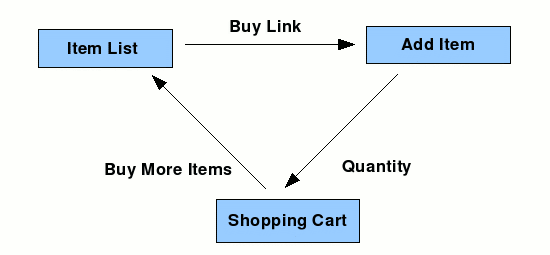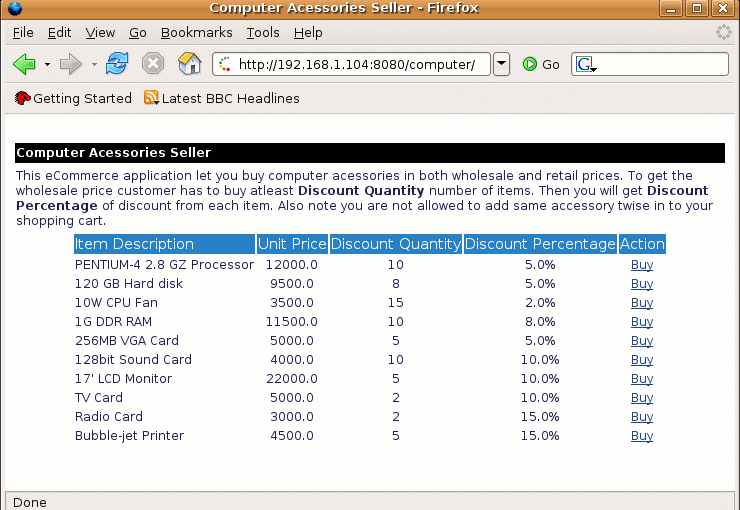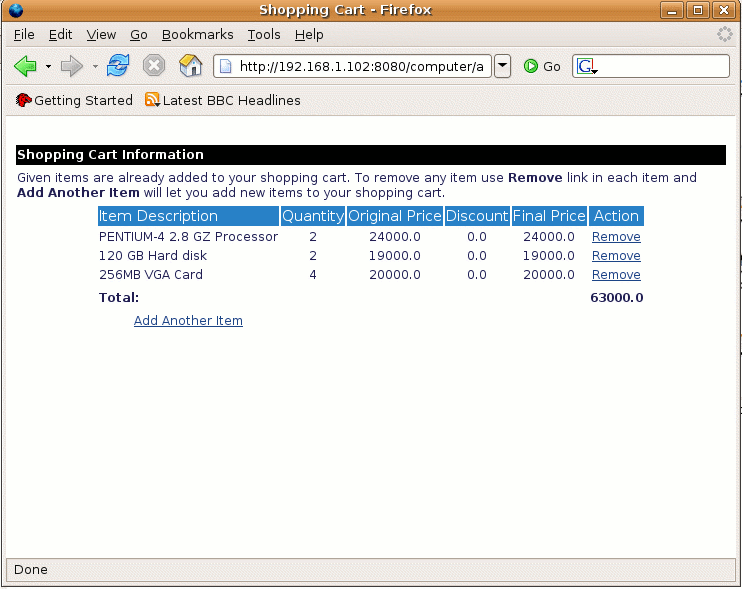

|
| Home > Apache Geronimo v1.1 > Documentation > Apache Geronimo v1.1 - User's Guide > Migrating to Apache Geronimo > JBoss to Geronimo - EJB-Session Beans Migration |
A typical J2EE application may contain Enterprise JavaBeans or EJBs. These beans contain the application's business logic and live business data. Although it is possible to use standard Java objects to contain your business logic and business data, using EJBs addresses many of the issues of using simple Java objects, such as scalability, lifecycle management and state management.
This document discusses one type of EJBs, the Session EJB. This type of EJBs are useful for mapping business process flow (or equivalent application concepts). There are two types of Session EJBs, stateless and stateful. This article addresses both these Session Bean types and shows how to use them in a practical scenario.
EJBs hold conversations with clients. A conversation is basically an interaction between the EJB and the client and these interactions are composed of method calls by the clients to the EJBs. Stateful session beans retain state on behalf of a client. This means that if the state of the bean changes during a client's method call, this state is retained for subsequent calls by the same client. A stateless session bean on the other hand retains no conversational state from method to method. In other words, it is expected to hold its conversational state for only a single method call.
This article is organized in the following sections:
EJB implementation may vary from one vendor to another. The purpose of this section is to provide a session bean specific feature-to-feature comparison between JBoss and Apache Geronimo so you can clearly identify the differences and plan accordingly before migration.
| Feature | JBoss v4.0.5 | Apache Geronimo (OpenEJB) |
|---|---|---|
| Stateful and stateless Session Beans | supported | supported |
| BMP (Bean Managed Persistence) Entity Beans | supported | supported |
| CMP (Container Managed Persistence) Entity Beans | supported | supported |
| Message driven beans (MDBs) | supported | supported |
| Interoperability using RMI-IIOP or JAXRPC | supported | supported |
| Ability to expose stateless session beans and MDBs as Web Services | supported | supported |
| Support for sending and receiving messages via Web Services | supported | supported |
| Easy provisioning and hot deployment of EJB and JMX-based Web Services | supported | supported |
| Access to EJBs from external CORBA objects | supported | supported |
This is a simple eCommerce web site which sells computer related items in both retail and wholesale markets. To get the whole sale prices of items, customer has to buy at least given number of items. Otherwise he/she will get only retail prices of the item. End user of the application can add those items to their shopping cart. A stateless session bean has been used to manage the discount calculation business workflow activities while shopping cart of the application has been implemented with the help of a stateful session bean.
The following figure illustrates the application flow:

A customer of this application directly login to the item list page. It will give all the details of the items they have currently on their stock. To buy one of these items in the stock, use the Buy link which comes with each item. It will forward customer in to the Add Item to Cart web page. To proceed buying, customer has to enter the quantity of items he/she needs. If this quantity exceeds the minimum discount quantity, discounts will be granted and added items in to the customer's shopping cart. Shopping cart web page displays the list of items already added to the cart and it enables removing of items from the cart. This application will be not allow to add the same item shopping cart twise.
This eCommerce sample application also includes the following JSP pages:
The tools used for developing and building the Computer acessories seller application are:
The Eclipse IDE was used for development of the sample application. This is a very powerful and popular open source development tool. Integration plug-ins are available for both JBoss and Geronimo. Eclipse can be downloaded from the following URL:
http://www.eclipse.org![]()
Ant is a pure Java build tool. It is used for building the war files and populating the database for the Online Brokerage application. Ant can be downloaded from the following URL:
http://ant.apache.org![]()
This section shows you how and where the sample JBoss reference environment was installed so you can map this scenario to your own implementation. Note that for this migration example JBoss v4.0.5 was used.
Detailed instructions for installing, configuring, and managing JBoss are provided in the product documentation. Check the product Web site for the most updated documents.
The following list highlights the general tasks you will need to complete to install and configure the initial environment as the starting point for deploying the sample application.
In order to build and run this sample application included in this article, you need to install and configure the Ant build tool.
As mentioned before, Apache Ant is used to build the binaries for the Online Brokerage application. If you do not have Ant installed this is a good time for doing it and make sure that <ant_home>/bin directory is added to the system's path variable.
Apache Ant can be downloaded from the following URL:
XDoclet is going to be used as build tool for the configuration file generation. It is an open source code generation engine. It enables Attribute-Oriented Programming for java. In short, this means that you can add more significance to your code by adding meta data (attributes) to your java sources. This is done in special JavaDoc tags.
Although XDoclet originated as a tool for creating EJBs, it has evolved into a general-purpose code generation engine. XDoclet consists of a core and a constantly growing number of modules. It is fairly straight forward to write new modules if there is a need for a new kind of component.
http://xdoclet.sourceforge.net/xdoclet/index.html![]()
Just extract the latest version of the XDoclet and set the xdoclet.home parameter in to the build.properties file.
The computer acessories selling application included with this article provides an Ant script that you will use in order to build the application. Download the computer acessories selling application from the following link:
After extracting the zip file, a computer directory is created. In that directory open the build.properties file and edit the properties to match your environment as shown in the following example:
## Set the Geronimo 1.1 home here geronimo.home=<geronimo_home> ## Set XDoclet 1.2.3 Home xdoclet.home=<xdoclet_home>
Before starting the build process just set the correct paths for the geronimo.home and xdoclet.home entries in the build.properties file in the config directory.
From a command prompt or shell go to the computer directory and run ant jboss. This will build the ear file and place it directly in the releases/jboss directory.
To deploy the sample application just copy the computer.ear will be created under the computer/releases/jboss folder to the <jboss_home>/server/<your_server_name>/deploy folder.
If JBoss is already started, it will automatically deploy and start the application; otherwise, the application will be deployed and started at the next startup.
To test the application, open a Web browser and access the following URL:
http://localhost:8080/computer![]()
This brings up the item list page of the computer acessories selling application. You can buy computer acessories using this application. The application is now configured and running.

Following is the demonstration of a shopping cart of the sample application.

Download and install Geronimo from the following URL:
http://geronimo.apache.org/downloads.html![]()
The release notes available there provide clear instructions on system requirements and how to install and start Geronimo. Throughout the rest of this article we will refer to the Geronimo installation directory as <geronimo_home>.
| TCP/IP ports conflict If you are planning to run JBoss and Geronimo on the same machine consider to change the default service ports on, at least, one of these servers. |
When you built the computer acessories selling sample application, Ant packaged the deployment descriptors for both JBoss jboss.xml and Geronimo openejb-jar.xml as they were already provided by the sample application. These files are located in the computer/config directory.
The following example shows the JBoss deployment descriptor.
<?xml version="1.0" encoding="UTF-8"?> <jboss> <enterprise-beans> <session> <ejb-name>ShoppingCart</ejb-name> <local-jndi-name>ShoppingCart</local-jndi-name> <method-attributes> </method-attributes> </session> <session> <ejb-name>ItemService</ejb-name> <local-jndi-name>ItemService</local-jndi-name> <method-attributes> </method-attributes> </session> </enterprise-beans> <resource-managers> </resource-managers> </jboss>
Compare it with the contents of the Geronimo deployment plan shown in the following example.
<?xml version="1.0" encoding="UTF-8"?> <openejb-jar xmlns="http://www.openejb.org/xml/ns/openejb-jar-2.1"> <dep:environment xmlns:dep="http://geronimo.apache.org/xml/ns/deployment-1.1"> <dep:moduleId> <dep:groupId>org.apache.geronimo.samples</dep:groupId> <dep:artifactId>ComputerEJB</dep:artifactId> <dep:version>1.0</dep:version> <dep:type>car</dep:type> </dep:moduleId> <dep:dependencies/> <dep:hidden-classes/> <dep:non-overridable-classes/> </dep:environment> <enterprise-beans> <session> <ejb-name>ShoppingCart</ejb-name> <ejb-ref> <ref-name>ejb/ItemServiceLocal</ref-name> <ejb-link>ItemService</ejb-link> </ejb-ref> </session> <session> <ejb-name>ItemService</ejb-name> </session> </enterprise-beans> </openejb-jar>
First difference can be clearly noted is Geronimo specific configuration has more additional information than JBoss specific one. That part of the Geronimo configuration file is quite similar to a Maven 2 build script. Both of these given configuration files has EJB information. JBoss uses local JNDI names to link their EJBs while Geronimo directly use EJB's name. In addition to above differences also openejb-jar.xml file clearly gives the ejb reference information than jboss.xml file.
Looking at the web archive related configuration files give you few more differnces.
<?xml version="1.0" encoding="UTF-8"?> <jboss-web> <!-- EJB Local References --> <ejb-local-ref> <ejb-ref-name>ejb/ItemServiceLocal</ejb-ref-name> <local-jndi-name>ItemService</local-jndi-name> </ejb-local-ref> <ejb-local-ref> <ejb-ref-name>ejb/ShoppingCartLocal</ejb-ref-name> <local-jndi-name>ShoppingCart</local-jndi-name> </ejb-local-ref> </jboss-web>
<?xml version="1.0" encoding="UTF-8"?> <web-app xmlns="http://geronimo.apache.org/xml/ns/j2ee/web-1.1" xmlns:naming="http://geronimo.apache.org/xml/ns/naming-1.1"> <dep:environment xmlns:dep="http://geronimo.apache.org/xml/ns/deployment-1.1"> <dep:moduleId> <dep:groupId>org.apache.geronimo.samples</dep:groupId> <dep:artifactId>ComputerWeb</dep:artifactId> <dep:version>1.0</dep:version> <dep:type>car</dep:type> </dep:moduleId> <dep:dependencies/> <dep:hidden-classes/> <dep:non-overridable-classes/> </dep:environment> <naming:ejb-local-ref> <naming:ref-name>ejb/ItemServiceLocal</naming:ref-name> <naming:ejb-link>ItemService</naming:ejb-link> </naming:ejb-local-ref> <naming:ejb-local-ref> <naming:ref-name>ejb/ShoppingCartLocal</naming:ref-name> <naming:ejb-link>ShoppingCart</naming:ejb-link> </naming:ejb-local-ref> </web-app>
jboss-web.xml map the EJBs from their JNDI names as given the above while geronimo-web.xml uses directly EJB's name. The reference names given in each mapping will be used refer EJBs from the Servlets. web.xml file of the WAR file contains more information about each EJB reference name, which will be common to the both Geronimo and JBoss flavours of this application.
Build the migrated Geronimo version of the sample application by running following command from the computer directory.
ant geronimo
It will create computer.ear file in the computer/releases/geronimo folder.
To deploy the migrated Computer acessories selling application, make sure the Geronimo server is up and running.
Open Geronimo console in your browser and follow the given steps:
Once the application is deployed, open a Web browser and access the following URL:
http://localhost:8080/computer![]()
This article has shown how to migrate a sample application that uses Session Beans, from JBoss v4.0.5 to Apache Geronimo. This article provided step-by-step instructions to build the application, deploy and run it, and then migrate it to the Geronimo environment.
The following list summarizes the major differences found during this sample application migration.